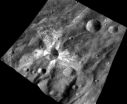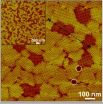(Press-News.org) Cambridge, Mass. - October 31, 2012 - Scientists have created new kinds of particles, 1/100th the diameter of a human hair, that spontaneously assemble themselves into structures resembling molecules made from atoms. These new particles come together, or "self-assemble," to form structures in patterns that were previously impossible to make and hold promise for manufacturing advanced optical materials and ceramics.
The method, described in the latest issue of the journal Nature, was developed by a team of chemists, chemical engineers, and physicists at New York University (NYU), the Harvard School of Engineering & Applied Sciences, the Harvard Department of Physics, and Dow Chemical Company.
The method is centered on enhancing the architecture of colloids—small particles suspended within a fluid medium. Colloidal dispersions are composed of such everyday items as paint, milk, gelatin, glass, and porcelain, but their potential to create new materials remains largely untapped.
Previously, scientists had succeeded in building rudimentary structures from colloids. But the ability use colloids to design and assemble complex 3-dimensional structures, which are vital to the design of advanced optical materials, has been limited. This is, in part, because colloids lack directional bonds, which are necessary to control particle self-assembly as well as to enhance complexity while maintaining the structural integrity of these creations. Such assemblies serve as the building blocks of the natural world—e.g., atoms and molecules—but they are rare in the colloidal domain.
"What this method aimed to do was to use nature's properties for atoms and apply them to the colloidal world," explained NYU chemistry professor Marcus Weck, one of the study's coauthors.
"Chemists have a whole periodic table of atoms to choose from when they synthesize molecules and crystals," added coauthor Vinothan Manoharan, Associate Professor of Chemical Engineering and Physics at Harvard. "We wanted to develop a similar 'construction set' for making larger-scale molecules and crystals."
In developing colloids with such properties, the researchers engineered chemical "patches" that can form directional bonds, thus allowing for the assembly of 3-dimensional "lattices" with only a few connections between particles, an important design element for many advanced materials. Without directional bonding, such structures are unstable.
The trick was establishing bonding capabilities on the patches. The scientists did so by using single strands of DNA, which scientists at NYU and elsewhere have previously employed to organize small particles. In the method described in Nature, these strands of DNA served as "sticky ends" to which particle patches could adhere.
"What this means is we can make particles that attach only at the patches, and then we can program them so only specific kinds of particles attach at those patches," said coauthor and NYU physics professor David Pine. "This gives us tremendous flexibility to design 3-dimensional structures."
The researchers added that the specificity of DNA interactions between patches means that colloids with different properties, such as size, color, chemical functionality, or electrical conductivity, could lead to the production of new materials. These potentially include 3-dimensional electrically wired networks or photonic crystals to enhance the optical displays of a range of consumer products and to improve the speed of computer chips.
INFORMATION:
Additional coauthors included Yufeng Wang (NYU), Yu Wang (NYU), Dana R. Breed (Dow Chemical Co.), Lang Feng (NYU), and Andrew D. Hollingsworth (NYU).
Key work was performed at NYU's Materials Research Science and Engineering Center, an interdisciplinary laboratory supported by the National Science Foundation.
The research was also supported by grants from the National Science Foundation (MR-0820341, ChE-0911460, DMR-0923251).
Assembly not required
Researchers from NYU, Harvard, and Dow Chemical create new microparticles that self-assemble like atoms into molecules
2012-11-01
ELSE PRESS RELEASES FROM THIS DATE:
Virtual reality 'beaming' technology transforms human-animal interaction
2012-11-01
Using cutting-edge virtual reality technology, researchers have 'beamed' a person into a rat facility allowing the rat and human to interact with each other on the same scale.
Published today in PLOS ONE, the research enables the rat to interact with a rat-sized robot controlled by a human participant in a different location. At the same time, the human participant (who is in a virtual environment) interacts with a human-sized avatar that is controlled by the movements of the distant rat. The authors hope the new technology will be used to study animal behaviour in ...
Global genome effort seeks genetic roots of disease
2012-11-01
By decoding the genomes of more than 1,000 people whose homelands stretch from Africa and Asia to Europe and the Americas, scientists have compiled the largest and most detailed catalog yet of human genetic variation. The massive resource will help medical researchers find the genetic roots of rare and common diseases in populations worldwide.
The 1000 Genomes Project involved some 200 scientists at Washington University School of Medicine in St. Louis and other institutions. Results detailing the DNA variations of individuals from 14 ethnic groups are published Oct. ...
Medical schools fall short on teaching students about obesity
2012-11-01
WINSTON-SALEM, N.C. – Oct. 31, 2012 -- It's no secret that obesity is a major problem in America.
More than one-third of adults and one-sixth of children are obese and it is one of the leading causes of preventable death. The costs associated with obesity are estimated at $99 million annually, comparable to the economic toll of cigarette smoking.
Despite all this, few U.S. medical schools are providing adequate, effective training on how to address weight issues in obese patients, according to researchers at Wake Forest Baptist Medical Center.
"Medical students are surrounded ...
New type of 'space weathering' observed on asteroid Vesta
2012-11-01
PROVIDENCE, R.I. [Brown University] — The surface of the giant asteroid Vesta is weathering in a way that appears to be completely different from any other asteroid yet visited, according to new data recorded by NASA's Dawn spacecraft. This new type of space weathering suggests that there's something about Vesta — perhaps its mineral composition or its position in the solar system — that makes its surface environment fundamentally different from other asteroids studied thus far.
The new data are presented in a paper published Nov. 1, 2012, in the journal Nature.
Space ...
Taming mavericks: Stanford researchers use synthetic magnetism to control light
2012-11-01
Magnetically speaking, photons are the mavericks of the engineering world. Lacking electrical charge, they are free to run even in the most intense magnetic fields. But all that may soon change. In a paper published in Nature Photonics, an interdisciplinary team from Stanford University reports that it has created a device that tames the flow of photons with synthetic magnetism.
The process breaks a key law of physics known as the time-reversal symmetry of light and could yield an entirely new class of devices that use light instead of electricity for applications ranging ...
OHSU researchers discover potential way to repair brain damage in multiple sclerosis
2012-11-01
PORTLAND, Ore. — Researchers at Oregon Health & Science University have discovered that blocking a certain enzyme in the brain can help repair the brain damage associated with multiple sclerosis and a range of other neurological disorders.
The discovery could have major implications for multiple sclerosis, complications from premature birth and other disorders and diseases caused by demyelination – a process where the insulation-like sheath surrounding nerve cells in the brain becomes damaged or destroyed. Demyelination disrupts the ability of nerve cells to communicate ...
Spot the difference
2012-11-01
The 1000 Genomes Project today presents a map of normal human genetic variation – everything from tiny changes in the genetic code to major alterations in our chromosomes. In a DNA version of 'spot-the-difference', EMBL scientists and their colleagues studied the genomes of 1092 healthy people from Europe, the Americas and East Asia, systematically tracking what makes us different from each other. Their results, published in Nature, open new approaches for research on the genetic causes of disease.
"The 1000 Genomes Project has achieved something truly exceptional in ...
New study shows effects of prehistoric nocturnal life on mammalian vision
2012-11-01
AUSTIN, Texas — Since the age of dinosaurs, most species of day-active mammals have retained the imprint of nocturnal life in their eye structures. Humans and other anthropoid primates, such as monkeys and apes, are the only groups that deviate from this pattern, according to a new study from The University of Texas at Austin and Midwestern University.
The findings, published in a forthcoming issue of Proceedings of the Royal Society B, are the first to provide a large-scale body of evidence for the "nocturnal bottleneck theory," which suggests that mammalian sensory ...
Jamaican teen immigrants do better when they retain strong ties to original culture
2012-11-01
URBANA –Many young Jamaican immigrants are succeeding in the United States precisely because they remain strongly tied to Jamaican culture, said University of Illinois professor Gail M. Ferguson.
"Although many of these youths have forged a unique tricultural identity that draws from their Jamaican culture, African-American culture, and mainstream European American culture, the important factor in their academic and behavioral success is retaining strong ties to their Jamaican background," she said.
To learn how Jamaican immigrant teens were adjusting to life in their ...
Folding funnels key to biomimicry
2012-11-01
Proteins are able to self-assemble into a wide range of highly ordered structures that feature a diverse array of properties. Through biomimicry - technological innovation inspired by nature – humans hope to emulate proteins and produce our own version of self-assembling molecules. A key to accomplishing this is understanding how protein-folding – a process critical to the form and function of a protein – is extended from individual proteins to complex assemblies.
Researchers with the U.S. Department of Energy (DOE)'s Lawrence Berkeley National Laboratory (Berkeley Lab) ...
LAST 30 PRESS RELEASES:
Targeting collagen signaling boosts drug delivery in pancreatic cancer
Valvular heart disease is common in cancer patients but interventions improve survival
When socially responsible investing backfires
Cuffless blood pressure technologies in wearable devices show promise to transform care
AI-based tool predicts future cardiovascular events in patients with angina
Researchers map how the cerebellum builds its connections with the rest of the brain during early development
Routine scans could detect early prostate radiotherapy changes
Fairness in AI: Study shows central role of human decision-making
Pandemic ‘beneath the surface’ has been quietly wiping out sea urchins around the world
Tea linked to stronger bones in older women, while coffee may pose risks
School feeding programs lead to modest but meaningful results
Researchers develop AI Tool to identify undiagnosed Alzheimer's cases while reducing disparities
Seaweed based carbon catalyst offers metal free solution for removing antibiotics from water
Simple organic additive supercharges UV treatment of “forever chemical” PFOA
£13m NHS bill for ‘mismanagement’ of menstrual bleeds
The Lancet Psychiatry: Slow tapering plus therapy most effective strategy for stopping antidepressants, finds major meta-analysis
Body image issues in adolescence linked to depression in adulthood
Child sexual exploitation and abuse online surges amid rapid tech change; new tool for preventing abuse unveiled for path forward
Dragon-slaying saints performed green-fingered medieval miracles, new study reveals
New research identifies shared genetic factors between addiction and educational attainment
Epilepsy can lead to earlier deaths in people with intellectual disabilities, study shows
Global study suggests the underlying problems of ECT patients are often ignored
Mapping ‘dark’ regions of the genome illuminates how cells respond to their environment
ECOG-ACRIN and Caris Life Sciences unveil first findings from a multi-year collaboration to advance AI-powered multimodal tools for breast cancer recurrence risk stratification
Satellite data helps UNM researchers map massive rupture of 2025 Myanmar earthquake
Twisting Spins: Florida State University researchers explore chemical boundaries to create new magnetic material
Mayo Clinic researchers find new hope for toughest myeloma through off-the-shelf immunotherapy
Cell-free DNA Could Detect Adverse Events from Immunotherapy
American College of Cardiology announces Fuster Prevention Forum
AAN issues new guideline for the management of functional seizures
[Press-News.org] Assembly not requiredResearchers from NYU, Harvard, and Dow Chemical create new microparticles that self-assemble like atoms into molecules




